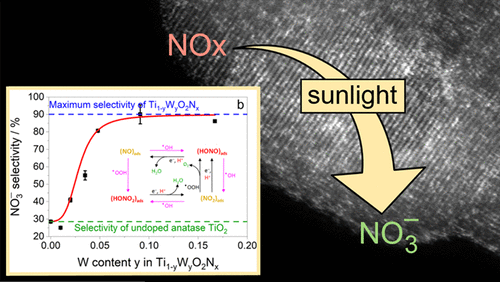当前位置:
X-MOL 学术
›
ACS Catal.
›
论文详情
Our official English website, www.x-mol.net, welcomes your feedback! (Note: you will need to create a separate account there.)
Improving the Selectivity of Photocatalytic NOx Abatement through Improved O2 Reduction Pathways Using Ti0.909W0.091O2Nx Semiconductor Nanoparticles: From Characterization to Photocatalytic Performance
ACS Catalysis ( IF 12.9 ) Pub Date : 2018-06-12 00:00:00 , DOI: 10.1021/acscatal.8b00521 Andrea Folli 1 , Jonathan Z. Bloh 2 , Katherine Armstrong 1 , Emma Richards 1 , Damien M. Murphy 1 , Li Lu 3 , Christopher J. Kiely 1, 3 , David J. Morgan 1 , Ronald I. Smith 4 , Abbie C. Mclaughlin 5 , Donald E. Macphee 5
ACS Catalysis ( IF 12.9 ) Pub Date : 2018-06-12 00:00:00 , DOI: 10.1021/acscatal.8b00521 Andrea Folli 1 , Jonathan Z. Bloh 2 , Katherine Armstrong 1 , Emma Richards 1 , Damien M. Murphy 1 , Li Lu 3 , Christopher J. Kiely 1, 3 , David J. Morgan 1 , Ronald I. Smith 4 , Abbie C. Mclaughlin 5 , Donald E. Macphee 5
Affiliation

|
In this paper, we provide detailed insight into the electronic–crystallographic–structural relationship for Ti0.909W0.091O2Nx semiconductor nanoparticles, explaining the mutual electronic and magnetic influence of the photoinduced stable N- and W-based paramagnetic centers, their involvement in the photoinduced charge-carrier trapping, and their role in improving the nitrate selectivity of the photocatalytic oxidation of NOx to nitrates. In particular, reduced tungsten species in various crystallographic environments within the anatase host lattice were observed as playing a fundamental role in the storage and stabilization of photogenerated electrons. Here, we show how these reduced centers can catalyze multielectron transfer events without the need for rare and expensive platinum-group metals (PGMs). This allows for the versatile and elegant configuration of redox potentials. As a result, electron-transfer processes that are kinetically inaccessible with metal oxides such as TiO2 can now be accessed, enabling dramatic improvements in reaction selectivity. The photocatalytic abatement of NOx toward nontoxic products is exemplified here and is shown to pivot on multiple routes for molecular oxygen reduction. The same rationale can furthermore be applied to other photocatalytic processes. The observations described in this work could open new and exciting avenues in semiconductor photocatalysis for environmental remediation technologies in which the optimization of molecular oxygen reduction, together with the pollutant species to be oxidized, becomes a central element of the catalyst design without relying on the use of rare and expensive PGMs.
中文翻译:

通过使用Ti 0.909 W 0.091 O 2 N x半导体纳米颗粒的改进的O 2还原途径提高光催化NO x减排的选择性:从表征到光催化性能
在本文中,我们提供有关Ti 0.909 W 0.091 O 2 N x半导体纳米粒子的电子-晶体学-结构关系的详细见解,解释了光诱导的稳定的基于N和W的顺磁性中心的相互电子和磁性影响,以及它们的参与在光诱导的电荷载流子捕集中,以及它们在改善NO x的光催化氧化的硝酸盐选择性方面的作用硝酸盐。特别地,观察到锐钛矿主晶格内在各种晶体学环境中还原的钨物种在光生电子的存储和稳定中起着基本作用。在这里,我们展示了这些还原的中心如何能够催化多电子转移事件,而无需稀有和昂贵的铂族金属(PGM)。这允许氧化还原电势的多功能和优雅的配置。结果,现在可以利用金属氧化物(如TiO 2)进行动力学上不可及的电子转移过程,从而大大提高了反应选择性。NO x的光催化消除此处以向无毒产品迈进为例,并显示其在分子氧还原的多种途径上起着关键作用。同样的原理可以进一步应用于其他光催化过程。这项工作中描述的观察结果可以为环境修复技术开辟半导体光催化的新的令人兴奋的途径,其中分子氧还原的优化以及要氧化的污染物种类成为催化剂设计的核心要素,而无需依赖于使用稀有和昂贵的PGM。
更新日期:2018-06-12
中文翻译:

通过使用Ti 0.909 W 0.091 O 2 N x半导体纳米颗粒的改进的O 2还原途径提高光催化NO x减排的选择性:从表征到光催化性能
在本文中,我们提供有关Ti 0.909 W 0.091 O 2 N x半导体纳米粒子的电子-晶体学-结构关系的详细见解,解释了光诱导的稳定的基于N和W的顺磁性中心的相互电子和磁性影响,以及它们的参与在光诱导的电荷载流子捕集中,以及它们在改善NO x的光催化氧化的硝酸盐选择性方面的作用硝酸盐。特别地,观察到锐钛矿主晶格内在各种晶体学环境中还原的钨物种在光生电子的存储和稳定中起着基本作用。在这里,我们展示了这些还原的中心如何能够催化多电子转移事件,而无需稀有和昂贵的铂族金属(PGM)。这允许氧化还原电势的多功能和优雅的配置。结果,现在可以利用金属氧化物(如TiO 2)进行动力学上不可及的电子转移过程,从而大大提高了反应选择性。NO x的光催化消除此处以向无毒产品迈进为例,并显示其在分子氧还原的多种途径上起着关键作用。同样的原理可以进一步应用于其他光催化过程。这项工作中描述的观察结果可以为环境修复技术开辟半导体光催化的新的令人兴奋的途径,其中分子氧还原的优化以及要氧化的污染物种类成为催化剂设计的核心要素,而无需依赖于使用稀有和昂贵的PGM。



























 京公网安备 11010802027423号
京公网安备 11010802027423号